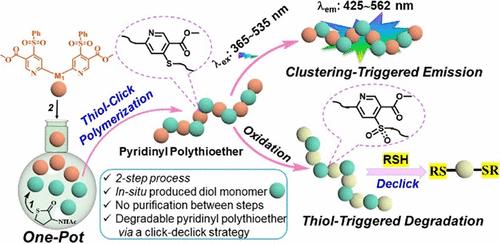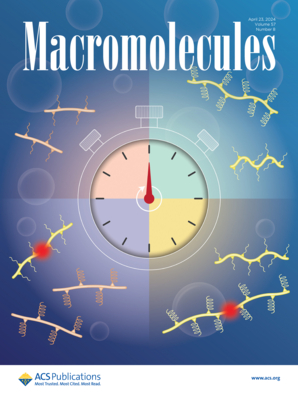Pyridinyl Polythioether via a One-Pot Thiolactone Ring-Opening and Thiol-Phenylsulfone Click Polymerization: Synthesis, Fluorescence, and Degradation Behavior
IF 5.1
1区 化学
Q1 POLYMER SCIENCE
引用次数: 0
Abstract
In this study, we synthesized a heteroaromatic thioether-containing polymer through the ring-opening of N-acetyl homocysteine thiolactone (NHTL) and thiol-heteroaromatic sulfone click polymerization in a one-pot approach. A dithiol monomer, produced in situ via NHTL ring-opening, was polymerized with a bis(phenylsulfone)-containing monomer through the click step-growth polymerization, resulting in the generation of a thermally stable polymer with pyridinyl thioether moieties in its main chain. The obtained polymer demonstrated clustering-triggered emission behavior due to electron-rich N, O, and S heteroatoms in the polymer structure. It was explored as a fluorescent polymeric probe to detect Cu2+ ions in the visible region. With H2O2/Na2WO4 as the oxidative reagent, thioether moieties in the polymer backbone were converted to sulfoxide/sulfone moieties. The resulting oxidized polymer underwent degradation through a declick reaction with a monothiol-containing compound. After the declick reaction of 2-mercaptoethanol and the oxidized polymer, a small molecule readily separated from the degradation product was recycled as a diol monomer to prepare polyurethane with a diisocyanate monomer. The pyridinyl thioether-containing polymer with clustering-triggered emission behavior exhibits potential as a new degradable material that can address environmental concerns and enhance sustainability in various applications.

求助全文
约1分钟内获得全文
求助全文
来源期刊

Macromolecules
工程技术-高分子科学
CiteScore
9.30
自引率
16.40%
发文量
942
审稿时长
2 months
期刊介绍:
Macromolecules publishes original, fundamental, and impactful research on all aspects of polymer science. Topics of interest include synthesis (e.g., controlled polymerizations, polymerization catalysis, post polymerization modification, new monomer structures and polymer architectures, and polymerization mechanisms/kinetics analysis); phase behavior, thermodynamics, dynamic, and ordering/disordering phenomena (e.g., self-assembly, gelation, crystallization, solution/melt/solid-state characteristics); structure and properties (e.g., mechanical and rheological properties, surface/interfacial characteristics, electronic and transport properties); new state of the art characterization (e.g., spectroscopy, scattering, microscopy, rheology), simulation (e.g., Monte Carlo, molecular dynamics, multi-scale/coarse-grained modeling), and theoretical methods. Renewable/sustainable polymers, polymer networks, responsive polymers, electro-, magneto- and opto-active macromolecules, inorganic polymers, charge-transporting polymers (ion-containing, semiconducting, and conducting), nanostructured polymers, and polymer composites are also of interest. Typical papers published in Macromolecules showcase important and innovative concepts, experimental methods/observations, and theoretical/computational approaches that demonstrate a fundamental advance in the understanding of polymers.
 求助内容:
求助内容: 应助结果提醒方式:
应助结果提醒方式:


